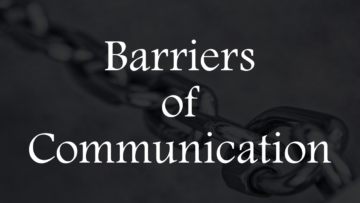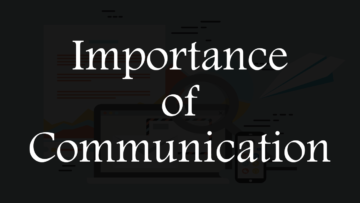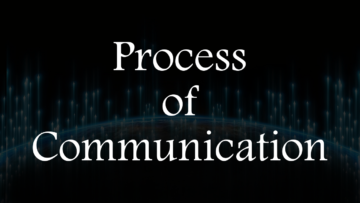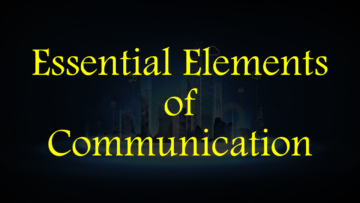Communication is not an extraordinary thing because everyone uses communication on a day-to-day basis. Talking to someone, expressing your thoughts etc. come under communication. When we talk to someone, we express our thoughts to the other person and he understands or tries to understand the thoughts expressed by us and gives us some answer or feedback in return, all these processes are called communication.
Communication is not a new thing as it has been in existence from as long as living things have existed. As time passed, communication improved, and new communication modes were invented and is happening now and will continue to happen.

Table of Contents
What is Communication?
Meaning of Communication
Communication is a process of transferring information from one to another. Information includes thoughts, opinions, feelings, emotions, facts, etc. and is transferred through oral, written and non-verbal means. Communication done through written mode is more valuable than other modes because written communication has more evidentiary value.
Communication is complete only when the receiver is able to understand the information sent by the sender and gives some answer or feedback in return. Communication will not be complete if the receiver is unable to understand the information sent by the sender and does not give some answer or feedback in return.
Definition of Communication
According to George Terry – “Communication is an exchange of facts, ideas, opinions or emotions by two or more persons.”
According to Theo Haimann – “It is the process of passing information and understanding from one person to another.”
According to Newman and Summer – “Communication is an exchange of facts, ideas, opinions or emotions by two or more persons.”
According to Koontz and ‘O’Donnell – “Communication is an intercourse by words, letter symbols or messages and is a way that one organization member shares meaning and understanding with another.”
Features of Communication
Following are the features of communication:
1. Two Parties:
At least two parties are required to complete communication, only one party cannot complete communication because one party sends information, and the other party receives it. In communication, the one who sends information is called the sender or communicator and the one who receives it is called the receiver or communicatee.
- First Party – Sender or Communicator
- Second party – Receiver or communicatee
2. Subject Matter:
Subject matter is one of the most important elements of communication because to complete communication subject matter is required such as idea, expressions, facts, messages, emotions, feelings, etc. Communication is not complete without subject matter.
3. Two-Way Process:
Communication is a two-way process because communication is complete only when both parties are involved in the communication. In communication, the sender sends information to the receiver, and in return, the receiver gives an answer or feedback to the sender.
4. Continuous Process:
Communication is a continuous process as it is used repeatedly till the existence of the object. For example, in business communication is used till the existence of the business.
5. Written, Oral and Gestural:
Communication can be written, oral, and gestural, it completely depends on the sender and receiver.
- Written communication means communicating through written mode.
- Oral communication means communicating through speaking.
- Gestural communication means communicating through expression, body language etc.
6. Formal and Informal:
Communication can be formal and informal, it entirely depends on the sender, receiver and nature of communication.
- Formal communication means communicating in a well-established way. It is commonly used in companies, organizations, etc.
- Informal communication means communicating in a non-established way. It is generally used among friends etc.
7. Direct and Indirect:
Communication can be direct and indirect, it completely depends on the sender, receiver, nature and place of communication.
- Direct communication means communicating directly face to face, it can be physical or virtual.
- Indirect communication includes all communications except direct communication.
8. Universal Process:
Communication is a universal process because everyone uses the concept of communication whether it is humans or animals. Without communication, no one can understand what the other wants to say.
Read Also:
QNA/FAQ
Q1. What is Communication?
Ans: Communication is a process of transferring information from one to another. Information includes thoughts, opinions, feelings, emotions, facts, etc. and is transferred through oral, written and non-verbal means. Communication done through written mode is more valuable than other modes because written communication has more evidentiary value.
Q2. Write the features of communication.
Ans: Following are the features of communication:
1. In communication, at least two parties are required.
2. Communication requires subject matter.
3. Communication is a two-way process.
4. Communication is a continuous process.
5. Communication can be written, oral and gestural.
6. Communication can be formal and informal.
7. Communication can be direct and indirect.
8. Communication is a universal process.
Q3. Does communication require at least two parties?
Ans: Yes, communication requires at least two parties.
1. First Party – Sender or Communicator
2. Second party – Receiver or communicatee
Q4. Is communication a universal process?
Ans: Yes, Communication is a universal process because everyone uses the concept of communication whether it is humans or animals. Without communication, no one can understand what the other wants to say.
Q5. Is communication a two-way process?
Ans: Yes, Communication is a two-way process because communication is complete only when both parties are involved in the communication. In communication, the sender sends information to the receiver, and in return, the receiver gives an answer or feedback to the sender.













